At my current job there are four employees who speak Russian. Three are younger programmers, one is an older janitor.
Related: my old post, The Unrussian Profession.
Blogging since 2002
At my current job there are four employees who speak Russian. Three are younger programmers, one is an older janitor.
Related: my old post, The Unrussian Profession.
In this timely book for contemporary cooks, Rainer Zinngrebe demonstrates his easy expertise in the often-misinterpreted field of fusion cuisine. He shows us how to do it properly, going beyond the ususal Pan-Asian themes and drawing on his classical European background and extensive experience in Asia and the USA.
I’ve been shopping for Japanese calligraphy scrolls lately. I wanted to purchase a scroll with a kanji “yume“, but instead ended up with “mu” instead. I purchased it without knowing what the character meant, just on the aesthetics of the brush strokes.
The concept of “mu” is touched upon in both Zen and the Art of Motorcycle Maintenance and Gödel, Escher, Bach. I’ve read both books (even if skipping large chunks) and understood maybe 5% of what the authors had to say. I really need to reread them a few times.
In the past I really hated graffiti and abstract art because they seemed meaningless to me. Now I like both, because Japanese calligraphy taught me that art can be both abstract and super specific at the same time.
My new calligraphy scroll is both a character that conveys a very specific word which has carries a meaning that Buddhist monks and computer programmers find very special, but is also a multitude of Rorschach test shapes. I see a woman’s head with flowing hair, a jumping fish, a Daruma doll’s head.

I wish I could read the three characters on the left as well as the information on the seals, find out who made this and when. My guess is that it’s Showa era, after the war, and that the calligrapher is very skillful.
I never received any musical instruction. My mother always believed that I did not have any musical talents. In fact, she used a Russian saying “медведь на ухо наÑтупил” (“a bear stepped on one’s ear”) to describe my musical aptitude. When I was little, I assumed the bear story to be literally true.
When I became a little older, I realized how lucky I was–many of my friends had to spend many, many hours studying music, and every one of them hated it. Those who studied music further, hated their lessons even more. I had one friend, for instance who used solfeggio as a curse word.
To this day I do not regret not getting a musical education: I feel that all that reading, fishing and playing that I’ve done instead of music lessons was a better use of my time. Besides, I think my mother wasn’t very much off in evaluation of my musical ability.
Having married into a musical family (my mother-in-law is a piano teacher and father-in-law is a senior tuner at Steinway and Sons), I have more music thrust in my life than I ever thought possible. My wife, an amateur organist, took up almost half of the living room space with an organ and a harpsichord. The mother-in-law and her take turns in bringing my baby daughter, whose entire vocabulary is limited to “papa”, “mama”, “baba”, and “kaka”, to the harpsichord keyboard and letting her hit the keys. My father in law has absolute pitch, but at this point it’s unclear if little Natalie inherited it or my own “bear-stepped-on” ears.
While a harpsichords and an organs are hardly common instruments, I bet every one of you has encountered a well-abused piano situated in a classroom. Invariably, some kid pulls up a chair and starts playing a simple melody. In the United States it’s usually a Chopsticks, in Russia–Dog’s Waltz.
It turns out that Chopsticks is actually called The Celebrated Chop Waltz and it’s composer is known. Dog’s Waltz’s, composer, on the other hand is unknown, but the tune has a wider international influence (also, musically, it’s a more interesting piece than Chopsticks).
Dog’s Waltz, as I learned from the Wikipedia article, is one of those things that has different names in different cultures. There are many examples of this: Russian roulette is known as American roulette in Russia, Mk 2 grenade is known as “pineapple grenade” in the US, but was called “lemon grenade” in Russian, cocks being called roosters in the US (for understandable reasons) and so forth.
The cultures don’t agree in what the said roosters sound like, with versions ranging from “cock-a-doodle-doo” to “goh-geh-goh-goh” to “chic-chi-ri-chi” and so forth. Cat sounds vary from culture to culture as well, and so do dog sounds.
In the similar manner, Dog’s Waltz has a multitude of names in different cultures, ranging from Cat March to Flea Waltz, Donkey March, Fools’ Polka, and The Little Monkeys. The Japanese, take the prize by calling it Neko Funjatta–I Stepped on the Cat. Interestingly enough, this tune is relatively unknown in the US.
Pilot: Welcome to Japan, folks. The local time is…tomorrow.
The Simpsons, Thirty Minutes Over TokyoIf you want to know what Japan is like architecturally, go watch Samurai Jack cartoons. The future world created by Genndy Tartakovsky looks a lot like present day Japan.
I picked some photos of buildings to give you a general idea of what I have seen. Here’s a Habitrails-inspired otaku-infested electronics shop in Akihabara.
Here’s a very elegant Stalinist-style skyscraper somewhere in Tokyo.
Philippe Starck blemished Tokyo skyline with a giant golden turd on the top of Asahi Beer Hall. It’s supposed to symbolize a flame that in turn is supposed to symbolize the company spirit of Asahi. Giggling tourists take a lot of pictures with creative shot framing. By the way, I’ve tried a lot of different beers that Asahi makes, and they all taste like, uh, flame. I, personally like Sapporo much better.
The Japanese society is highly stratified. For instance, in the hotel complex where I was staying there were at least 5 different classes of buildings (each of a different prestige level) and the ANA plane in which I travelled also had 4 or 5 types of seating. On this picture you can see two layers of Japanese society: well-designed plastic huts built by homeless with a backdrop of what I’m told is company-provided employee dorms.
Here’s an amazingly eclectic little building (I think it’s a firehouse). It combines elements of Art Deco, Modernism and traditional Japanese architecture.
And this building is pretty typical of modern designs. I love the huge wrap-around windows, the dna-like staircase and the efficient use of space.
I was most shocked by architecture in Kyoto’s Gion, the geisha district. Near all-traditional Japanese buildings there was a number of super-futuristic mostly metal buildings that looked like spaceships. I think they were nightclubs of some sort. I’ve never seen anything like this anywhere else.
Many building tops had antenna clusters, one more cyber-punkey than the other.
As we all know, land is pretty tight in Japan. Here’s a pretty typical small house somewhere in Kamakura (I think).
What makes construction in such tight quarters possible is this marvel of technology: a cute pocket-sized excavator.
A policeman in his booth.
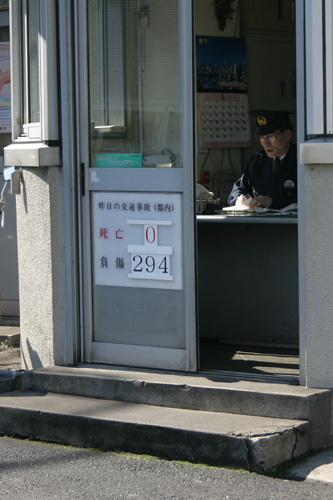
Rikshaw and his passengers in Arashiyama.
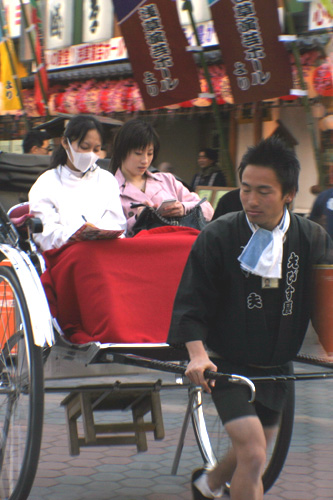
Outdoor eatery – Japanese really use a lot of space heaters.
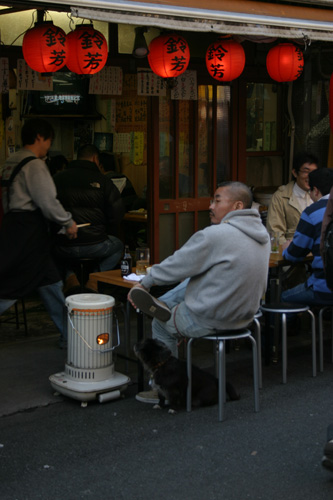
Ryokan owner in Kyoto.
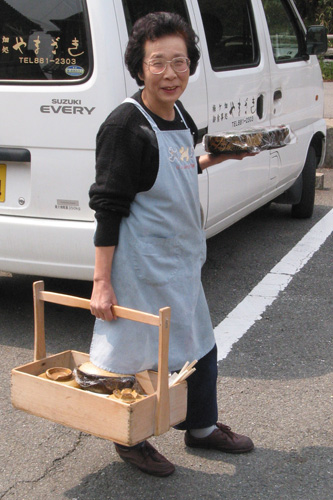
Snack vendors. The surgical masks are worn mostly by allergy sufferers – which due to a high number of pollen-producing Sugi trees planted are about 1 in 5.
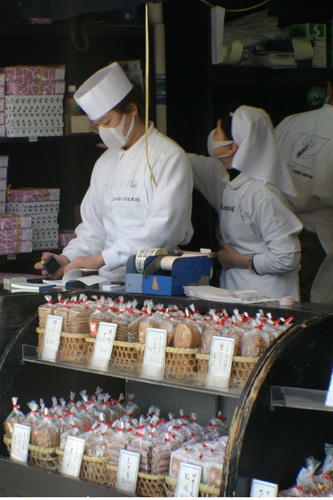
Some take pictures of the cherry blossoms, others take a more traditional approach.
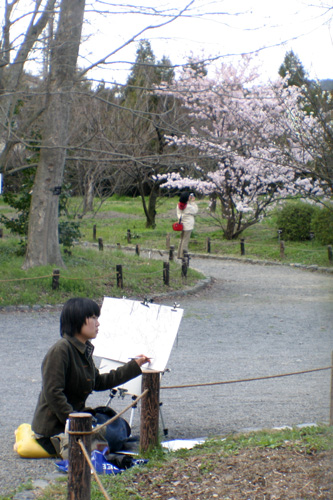
Riding on the Shinkansen.
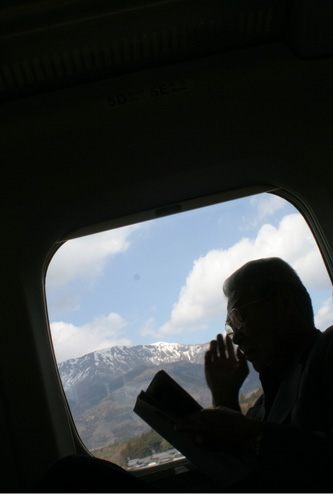
Kids visiting Zeniarai Benten temple.
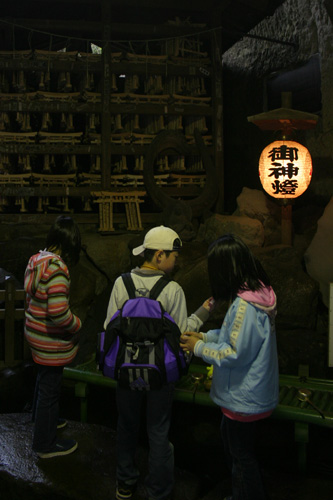
In a museum.
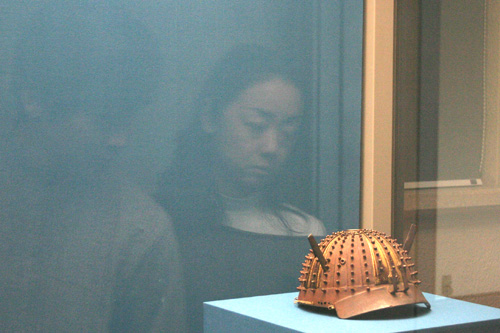
Akihabara girl handing out promotional packs of napkins – kind of like a booth bunny without a booth.
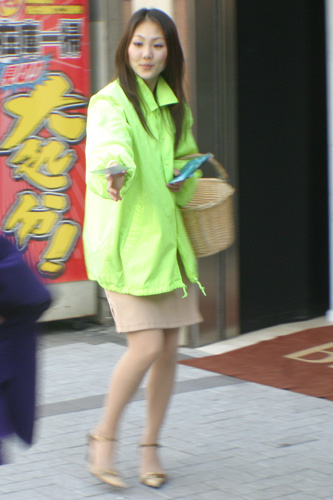
On a JR train.
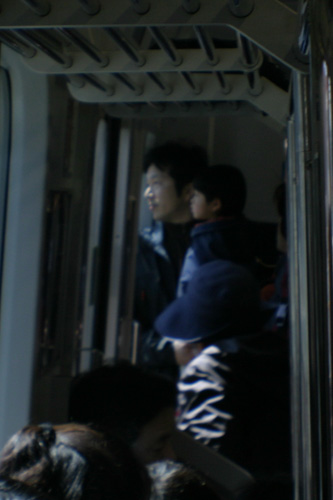
.
Consulting a fortuneteller.
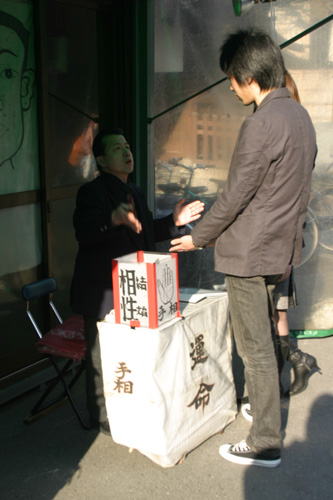
I was rather surprised at home many people wear kimonos. I noticed that a lot of shopkeepers wear traditional clothing, it must help with projecting the traditional image
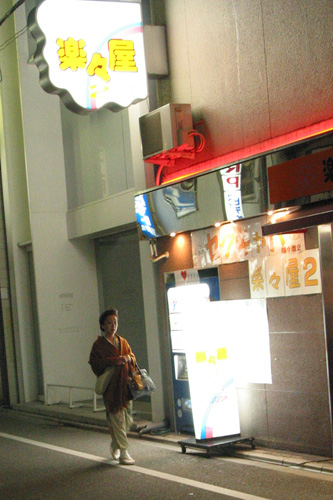
Another snack vendor.
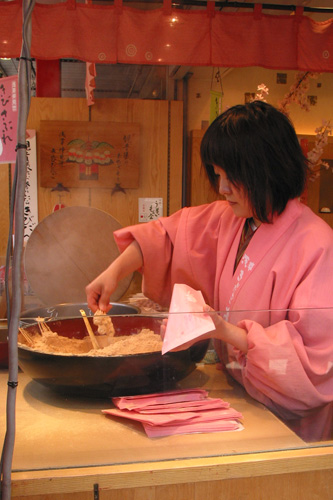
Shinkansen driver. Don’t the white gloves make you feel safer somehow?

Squid on a stick vendor
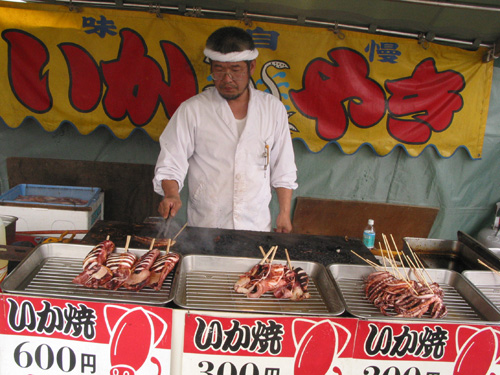
Celebrating Hina Matsuri – Girl’s Day.
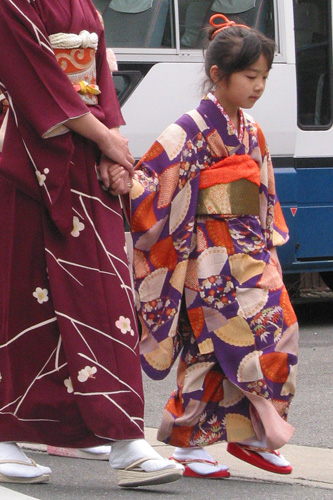
Cloth painter. My wife bough a shopping bag with sakura blossom design.
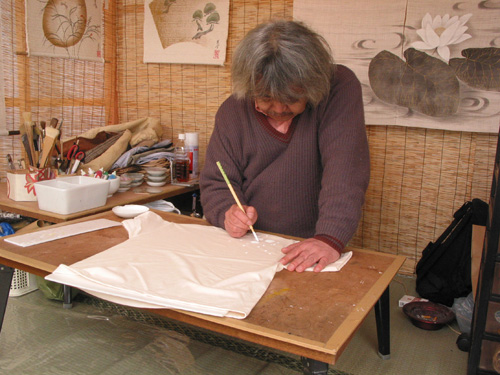
Fishermen.
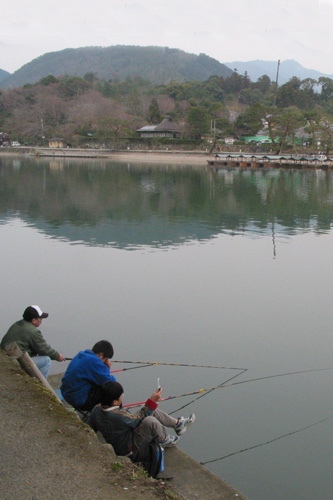
Lumber vendor in his shop.
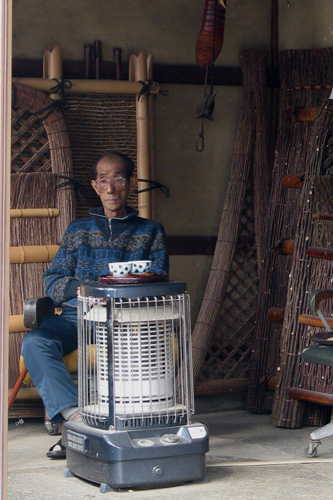
Restaurant worker.
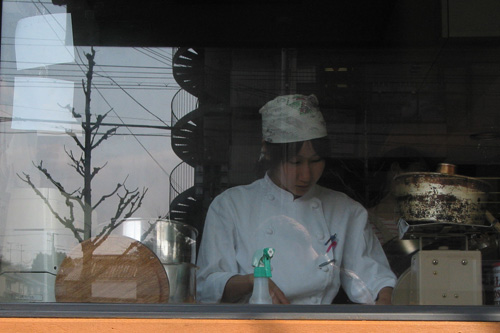
On bikes.

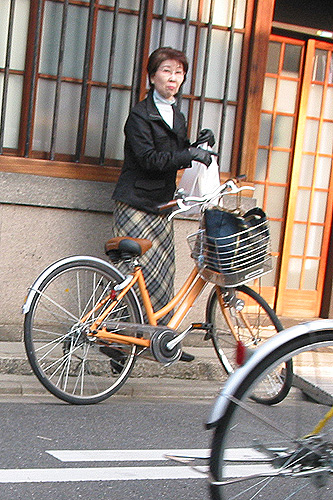

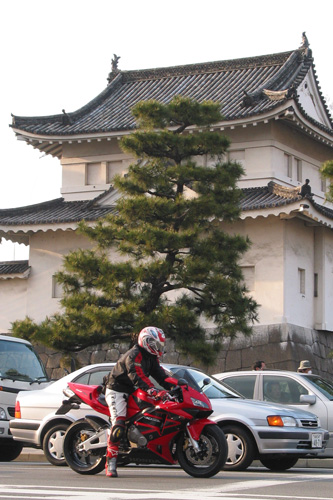
What is the the first ever sister city to be twinned with NYC? That’s right, Tokyo, Japan. And nowhere it’s more apparent than in Brooklyn, at the annual Cherry Blossom Festival (aka Sakura Matsuri) that is held at the awesome Brooklyn Botanic Garden.
You know that word that the Naked Chef likes to say a lot? “Pukka”? It turns out to be a Hindi word meaning “authentic” and “first class.” Well, on the minus side many Japanese things in Brooklyn Botanic are not pukka at all.
For instance, the Japanese Hill-and-Pond Garden is a masterpiece of true Japanese garden design. But the house and the Shinto shrine are empty shells and not authentic at all. If you want to see a real Japanese house you have to go to Philly to see Shofuso. I don’t even know where the closest real Shinto shrine is.
Also, would it kill them to have a decent bento? They always sell the worst bentos ever at Sakura Matsuri. They should totally get in touch with Shinobu Kobayashi, Mainichi Daily News bento specialist.
These are all minor gripes though. I love Sakura Matsuri at Brooklyn Botanic. I especially love the distinctly Brooklyn flavor that it acquires.
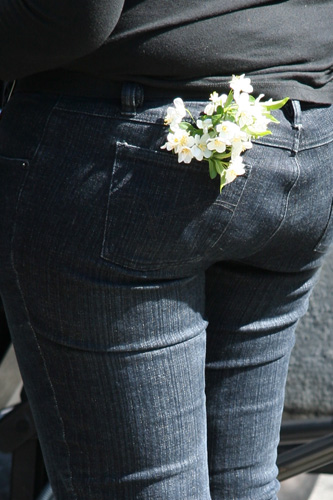
How awesome is this lady’s kimono? My wife wore a vintage Haori that we bought in a second hand store in Arashiyama.
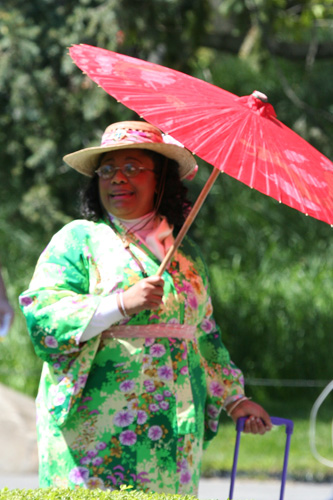
Those without cromulent attire can compensate with appropriate coiffure.
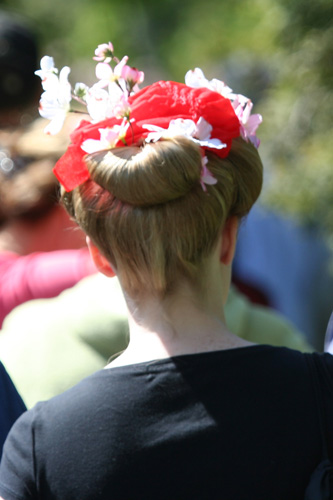
Brooklyn badass samurai, wearing dark sunglasses
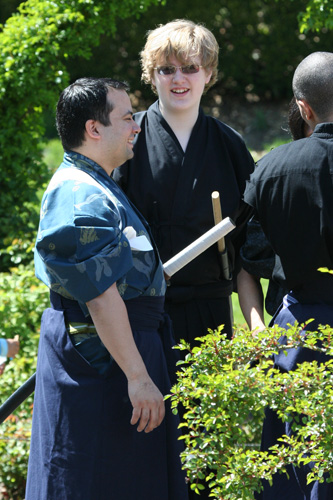
and cutoff kimonos.
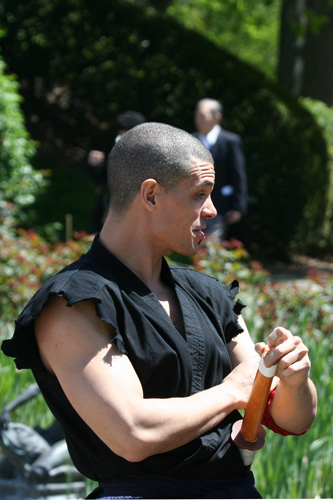
There’s some meditatin’ going on.
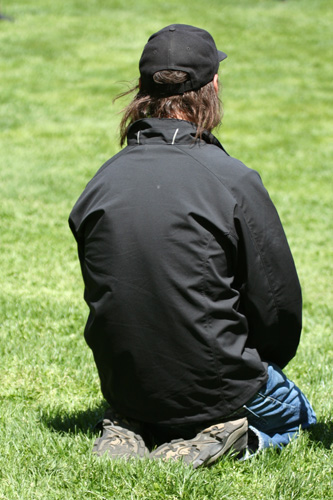
And mingling of food.
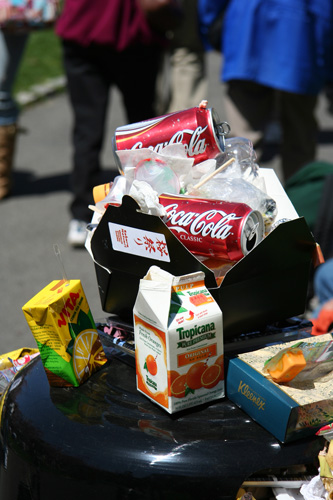
In the end, you can appreciate the cherry blossoms amongst the throngs of people, just like in Japan. It’s that just that the cops won’t let you get drunk under the cherry trees, like they do in Japan.
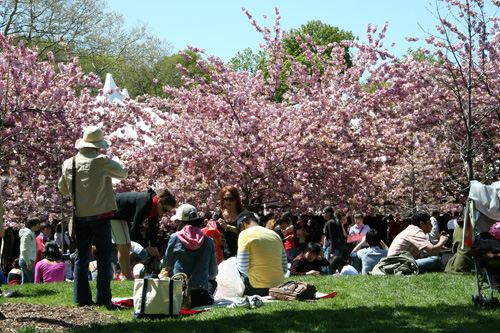
Money-making schemes are a on my mind a lot lately, so here’s a little bit about ingenious schemes by which Japanese monks are raising money.
As I don’t have much understanding of Buddhism and Shinto, Japanese temples did not leave much impression upon me. After a while, they all started to look alike. One common element was the fundraising gimmicks used by the monks which I found rather ingenious.
First up, there’s omikuji, literally “sacred lottery.” You deposit a 100 yen (about $1) coin in a slot (on an honor system), shake a metal container with wooden stick marked with a hieroglyph (probably a number), match it up to a drawer and take out a sheet of paper. The fortunes contain a variety of outcomes, from blessing – dai-kichi (now I know what Daikichi Sushi restaurants are named after:), through lesser forchunes such as near-small-blessing, sue-shÅ-kichi, and to great curse – dai-kyÅ.
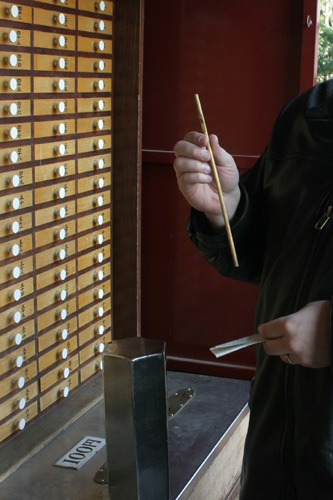
The genius of the system is that if you don’t like your fortune, you can tie it on special pine planks (according to Wikipedia it’s a pun – “pine tree” is “matsu” and “to wait” is “matsu”). Then you can try again.
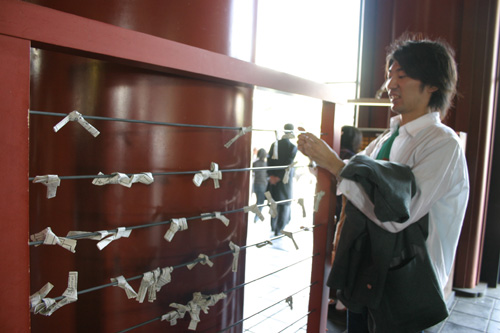
Somewhere, I think it was near Ryoan-ji Temple I encountered this attraction. A little statue of a deity with a little bowl next to it. From what I understand, you need to throw a coin into the bowl for good luck. As you can see, it’s not too easy. My wife managed to get a 5 yen coin in though.
Here are temple workers collecting the bounty. They even have little bamboo rakes!
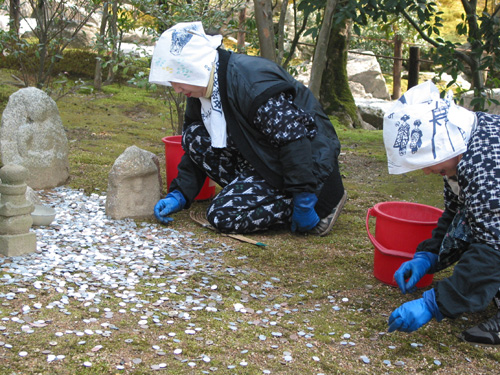
Then there’s Zeniarai Benten Shrine, where you can rent a special basket to wash your money is an underground spring, that is supposed to double your money. I hope washing a banking card works too :)
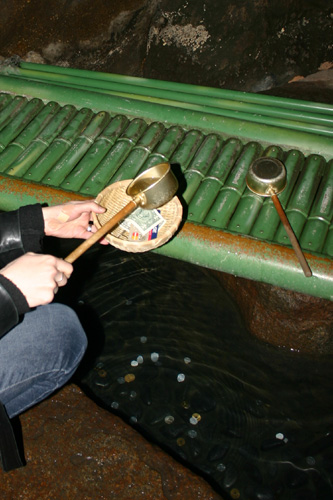
I’d like to finish this with a little news item that I pulled from Mainichi news: Man who stole 2 yen from shrine sentenced to 22 months behind bars. A yen is about 1 cent. Pretty rough, eh? Well, the article goes on to say that he also stole some batteries…
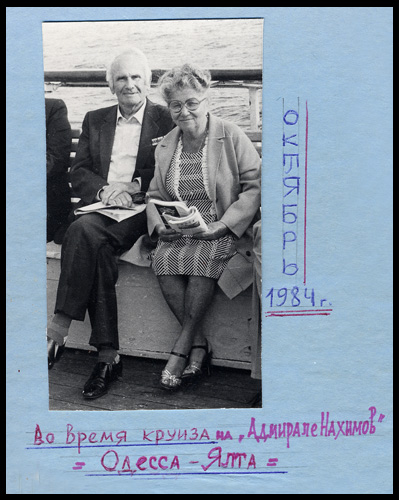
My paternal grandmother, the matriarch of the family, a mechanical engineer and a workaholic, was the main driving force behind our move to America. She woke up at 5 am every day to prepare a meal for the family and start cleaning. She loved America, but did not live long enough to enjoy her life here. Her luck ran out a several years after my family arrived in the US — pancreatic cancer destroyed her body. The surgeons operated, but could not help her.
My grandfather, on the other hand was a bit luckier. He also had an operation in the US – a quadruple bypass, which fixed his heart that was weakened by several small heart attacks. In all likelihood, if he did not immigrate, his heart would have given out earlier, as these operations were not widely available in Ukraine.
Gramps lived an extraordinary life, squeaking by on his luck more than once. The picture of him and my grandma you see above is from their vacation on a Soviet cruise ship. I took a scan from a page of my personal photo album that he lovingly created for me, complete with his accurately printed titles. “October 1984, Cruise on ‘Admiral Nakhimov’, Odessa-Yalta” the caption reads. In August 1986, Admiral Nakhimov became the Soviet Titanic, colliding with cargo ship Pyotr Vasyev, mostly though gross incompetence of and dereliction of duty by the two captains.
Having survived Stalin’s purges was mostly pure luck for my grandparents. Having relatives in the USA actually tipped the odds in the wrong direction. My grandparents did have a chance to emigrate in the pre-war wave. One of my grandpa’s friends tried to talk him into going to America and starting a construction business. Good construction engineers like you are hard to find there, he said. My grandma did not want to go at that time, leaving their elderly parents behind. I remember seeing a letter from my grandpa’s friend, who actually started a construction business in the US and struck it rich. The zip code on the letter stuck in my mind for some reason back then, and now I know what it meant — it was 90210. In any case, I think the major reason why my grandfather did not get arrested adn “disappeared” is his easygoing personality. He was a very gentle person, with a small circle of good friends and absolutely no enemies. That, and his luck.
My grandfather had some luck in WWII as well. Very early on in the war a few of his egghead friends called on him to volunteer to a newly formed and somewhat secret division. He spent the war very close to the hottest front points, but not actually in them. He did not shoot or got shot at. In fact, he was handling lots and lots of paperwork. That paperwork was generated by strange-looking cars with antennas, egg-headed mathematicians and grandpa’s friends, who were fluent in several languages. I always knew my grandfather as an extremely meticulous person, especially about paperwork. This quality is very important in the business of code breaking as well as in the construction business.
After the war gramps was poor as a churchmouse. His wartime spoils were limited to the fork and the polishing cloth that I wrote about earlier. To fix their finances my grandparents headed to the boom island of Sakhalin. Sakhalin is an island right next to Japan that looks like a fish from above. The history of Sakhalin’s population is strange and convoluted. Chinese, Japanese, Ainu, Russians and others co-inhabited it. Japan and Russia fought for complete control of it, and finally, after WWII Soviet Russia won. Japanese were driven out and it became a Soviet frontier, rich in oil and other natural resourses. Engineers were desperately needed, and even within the confines of non-market economy, wages were much higher there. My grandparents made a good living there, sending money back to their parent and saving a lot to start their independent life back in Odessa. My dad, whom they took along, meanwhile, learned to ski and to catch smelts, strange little fish that smell like fresh cucumbers.
Back to Odessa they went, where they continued their careers. They bought a few things with their Sakhalin earnings, such as the nice modern furniture and a color TV that I later enjoyed. There are many buildings in Odessa that were built under the supervision of my grandfather. Later he became a college instructor, and taught architects and builders.
Without ever hearing about another famous Odessan who also happens to share his first name, one Yakov Pokhis better known as Yakov Smirnoff, gramps liked to repeat the famous catchphrase. “What a country! What won’t they think of!” — he used to say when I showed him a gadget or when he read about something in a newspaper or saw something on TV.
Grandfather’s luck ran out at the age of 91. He caught pneumonia. In the hospital, he started to get a little better, but then suddenly coded. His heart probably simply gave out, and the house doctor could not revive him. I talked to that doctor, and it was bad. Decent doctors say “I am sorry for your loss” and not “what is it that you want to know”; they do not mix pronouns, even if they speak broken English. I can only hope that he did everything that he could to save my grandfather.
Here’s literally the last picture I ever took of him (it was earlier this year). My latest digital camera and flash impressed gramps a lot, as it came a long way from the huge camera he and his father used to have (I pointed out that the quality of that old-timey camera was probably better).
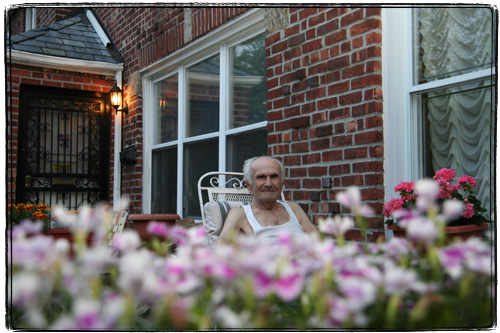
As I learned from the eulogy delivered by a rabbi at the funeral, 91 is a special age. In Hebrew letter code 91 means Amen. Aleph = 1, Mem = 40, Nun = 50. Gramps lived a good life, and I am very grateful for having him with us that long. I am also grateful that his death was quick and I hope mostly without suffering. He is finally back with grandma. Amen.
And now welcome to yet another edition of “Gastronomic Adventures with Deadprogrammer”. Since I wrote previous installments I’ve noticed that I am not the only blogger who takes the time to purchase and eat weird stuff. The Sneeze is home to outstanding section called “Steve, Don’t Eat It!”
I’ve read an article (though I can’t remember who wrote it) about the fact that many gourmet foods are initially repulsive to most people. The first signal your brain sends you when your are having oysters, stinky cheese, scotch or caviar is “Dude! This stuff is spoiled, spit it out right now!”. But then, you consciously think, “Come on, brain, this is 25 year old Talisker we are having here. I just paid $225 for the bottle, you better relax and try to enjoy it. Yes, I know that it tastes like peat a little bit. It’s supposed to. It’s a good thing”.
The ultimate gourmet food for which you need to fight with your brain is Durian. Available in most oriental stores in New York, this pointy skinned exotic fruit is widely known for smelling awful but tasting heavenly.
Recently I purchased one on my trip to Avenue U, which is more and more becoming Brooklyn’s Chinatown. Here it is, sitting innocently on my Naked Chef-style cutting board.
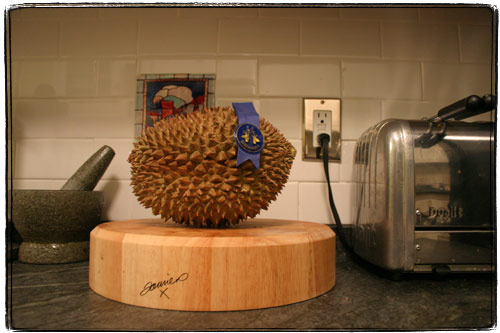
When you cut it with a knife, you find several sections filled with custard-like flesh and big seeds.
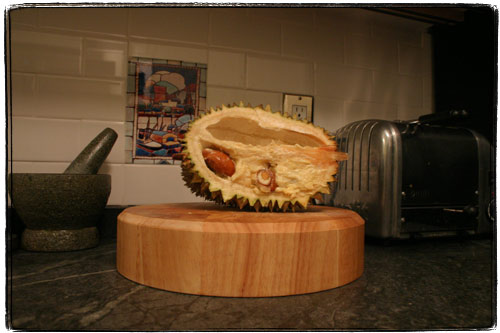
I have to say that the smell was not as horrible as most places describe it. It was definitely odd, somewhat unpleasant, but not completely overpowering. I found it similar in strength and quality to the smell of expensive sulfur spring mineral water that you might find in many resorts. Nothing even close to the horrors that you might find in any article describing Durian on the web.
The taste and texture of the fruit flesh was absolutely great. It had the texture and sweetness of a creamy custard, very smooth and buttery, tasting somewhat like pineapple, lemon and banana at the same time. It was very sweet, but not in a nauseating way. An absolutely unique taste, very, very exotic.
I can also happy to report not having any gas or any other digestive problems widely reported as associated with the fruit in question. On the other hand I did not eat the entire thing as I am still trying to watch my carbohydrate intake.
Apparently picking Durian is sort of a hit and miss experience. I had the most expensive kind my store had, an 89 cent/lb Mornthong variety. There are other varieties that are maybe stronger smelling and of lesser quality.